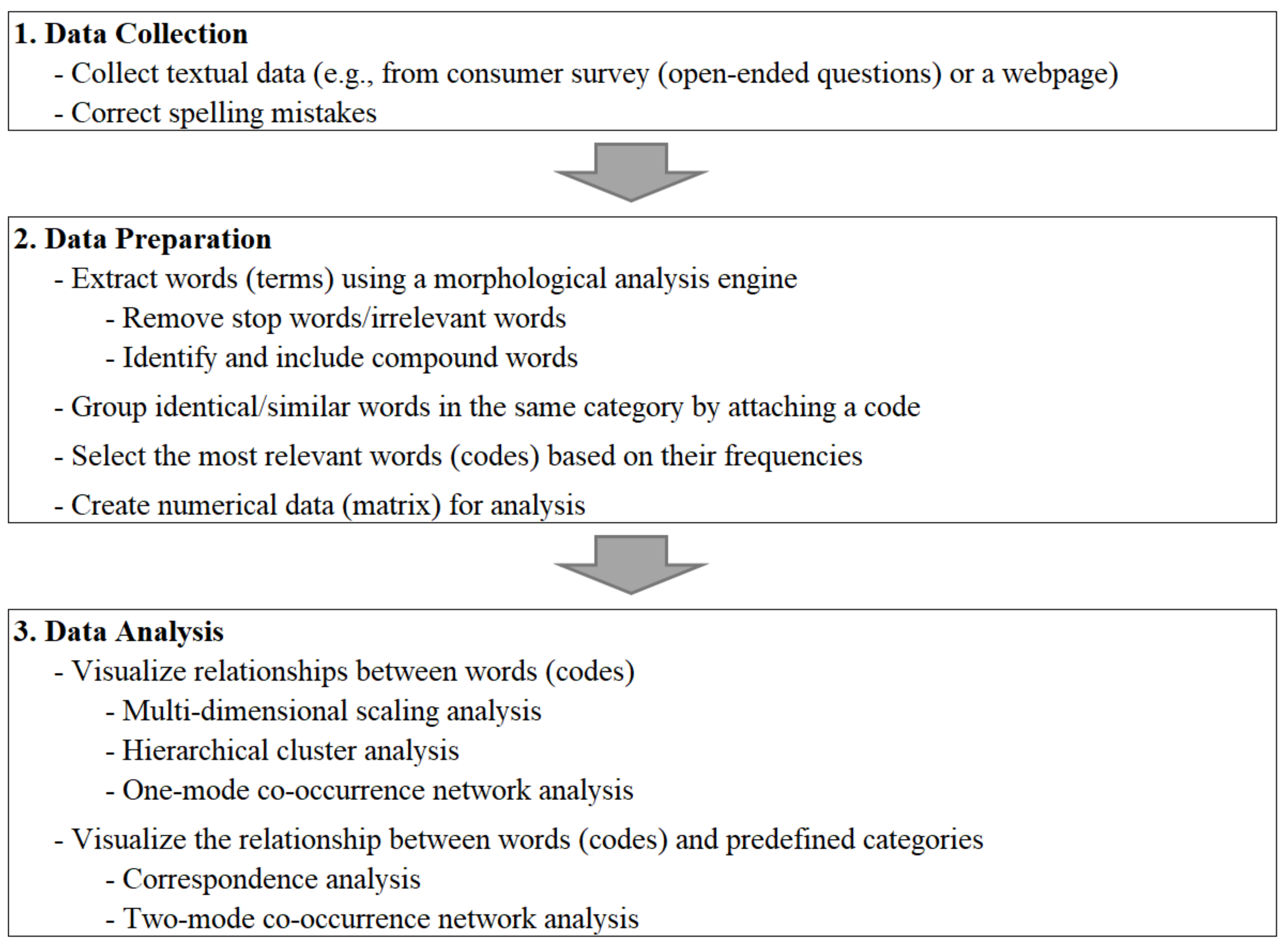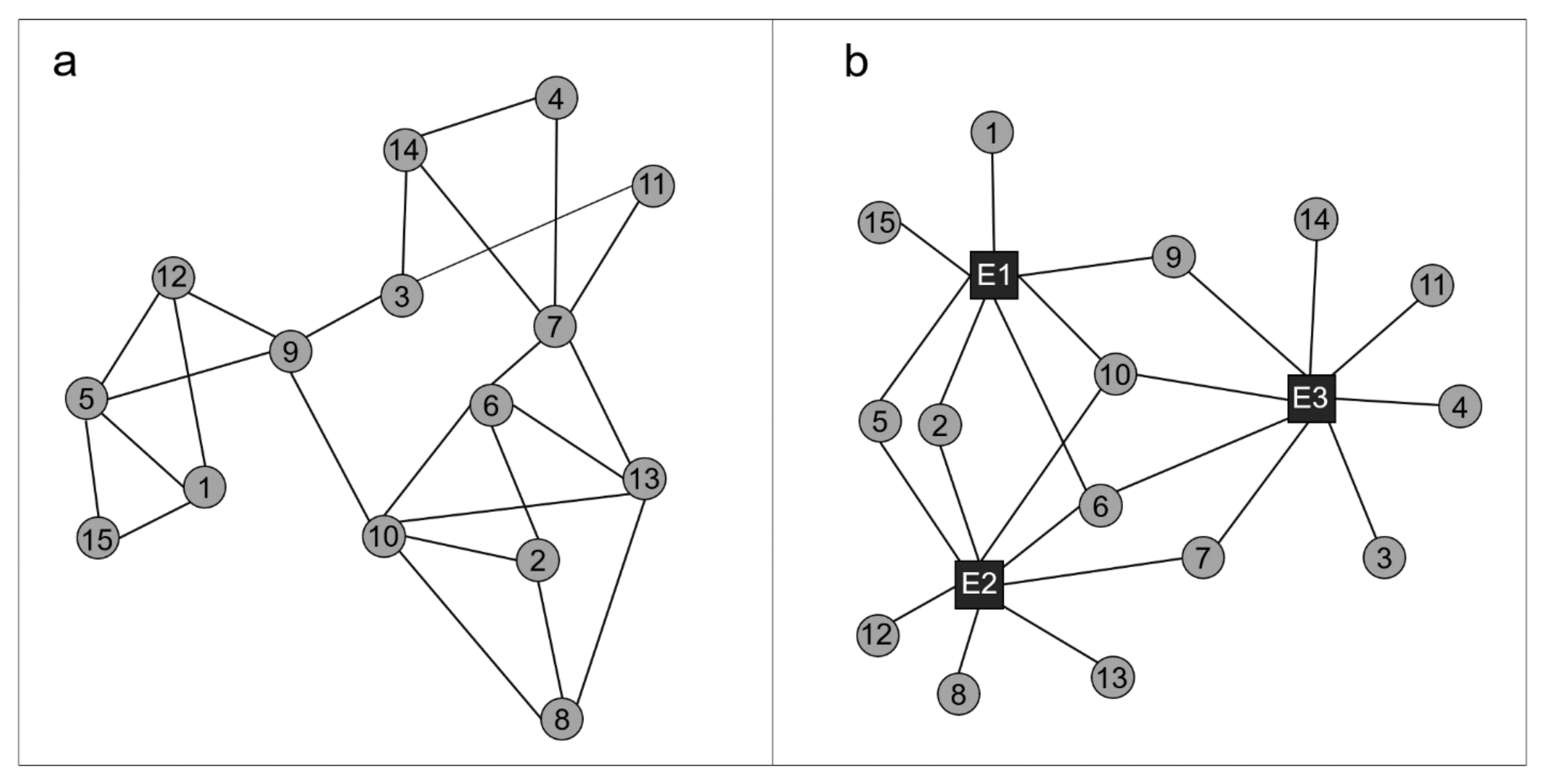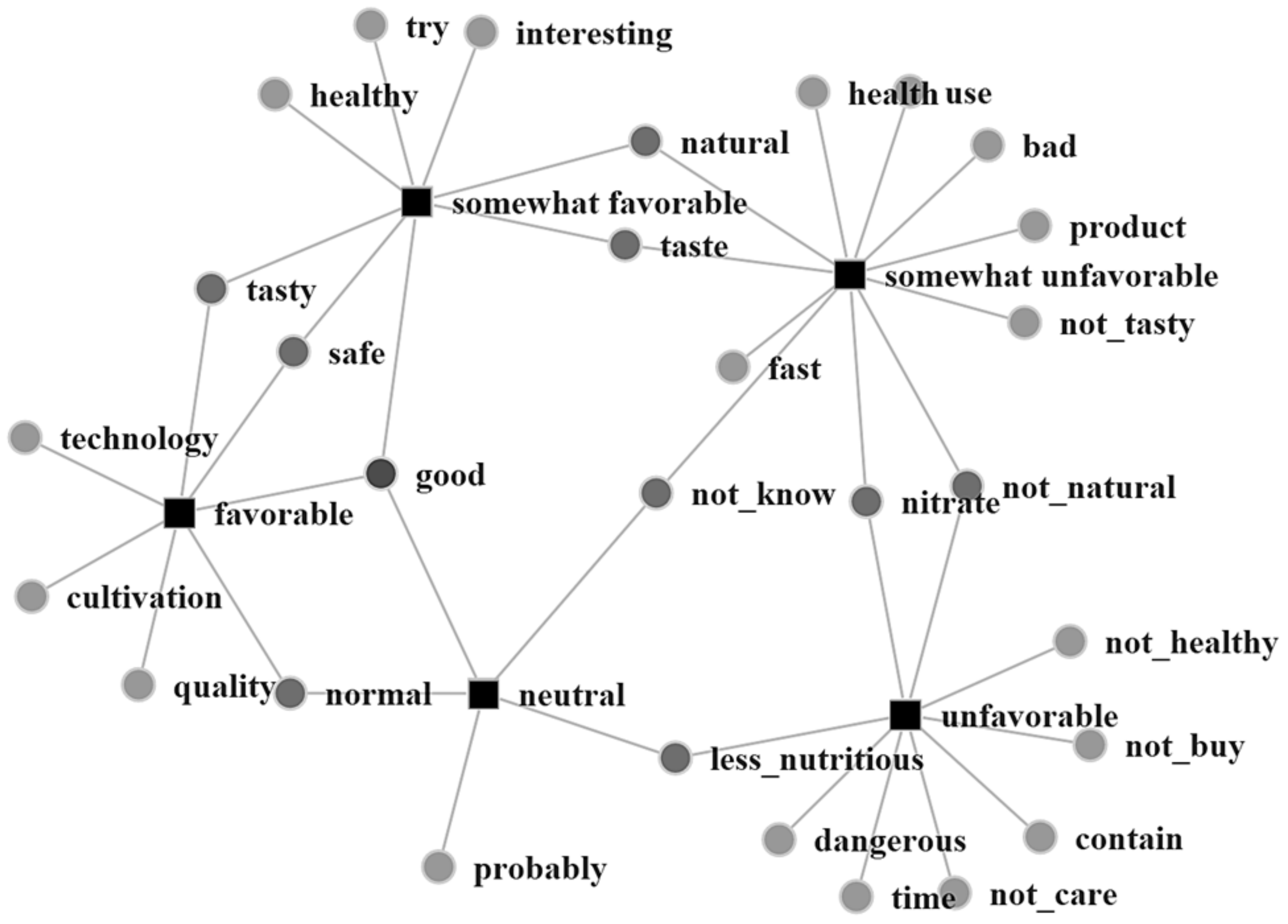Consumer Attitudes toward Vertically Farmed Produce in Russia: A Study Using Ordered Logit and Co-Occurrence Network Analysis
Abstract
1. Introduction
2. Materials and Methods
2.1. Data Collection and Preparation
2.1.1. Online Survey
2.1.2. Procedures for Text Processing
2.2. Data Analysis
2.2.1. Ordered Logit Model
2.2.2. Co-Occurrence Network Analysis of Two-Mode Data
3. Results
3.1. Favorability toward Vertically Farmed Leafy Vegetables
3.2. Ordered Logistic Regression
3.3. High-Frequency Words
3.4. Two-Mode Co-Occurrence Network Map
- Favorable: Words, such as “good,” “tasty,” “safe,” “quality,” and “technology”, appeared often in written comments from respondents who chose the “favorable” option. Their frequency indicates that some consumers had good impressions and that they believed leafy vegetables produced using the new technology were high in quality, safe, and tasty.
- Somewhat favorable: In comments by respondents who selected the “somewhat favorable” option, “good,” “tasty,” and “safe” again appeared frequently. However, words like “interesting,” “try,” “taste,” and “healthy” also appeared often. This finding suggests that respondents who had a somewhat positive feeling toward vertically farmed leafy vegetables also believed that they were safe and tasty. Furthermore, they were interested in trying them. Consumers in this group are expected to accept vertically farmed vegetables, depending on their quality, in particular their taste.
- Neutral: Respondents who reacted neutrally frequently mentioned “not_know,” “probably,” “good,” and “less_nutritious.” These words indicated no clear image of vertical farms and their produce. Because “not_know” is also connected to “somewhat unfavorable,” and “less_nutritious” is connected to “unfavorable,” the feelings of respondents who chose a neutral option presumably approximated those having negative emotions.
- Somewhat unfavorable: Relatively many words were linked to this option. “Not_know” again appeared frequently among respondents who selected the “somewhat unfavorable” option, indicating they also lacked a clear perception of vertical farms and their benefits. The occurrence of words (e.g., “product,” “not_natural,” “not_tasty,” “bad,” “health,” “use,” and “nitrate”) implies that respondents viewed vertically farmed leafy vegetables as unnatural, compared with vegetables grown outdoors. They tended to worry about the taste of the vegetables and the health effects of nitrates. Respondents’ use of the word “fast” shows that they believed vegetables grew quickly but unnaturally. The term, “fast growth,” is not necessarily a positive evaluation.
- Unfavorable: Words having negative meanings (e.g., “not_natural,” “not_healthy,” “less_nutritious,” “nitrate,” “dangerous,” “not_care,” and “not_buy”) appeared often among respondents who selected the “unfavorable” option. Members of this group were uneasy about consuming vegetables grown under artificial light because they believed that the vegetables were not natural, less nutritious, and even dangerous because of their nitrate contents.
4. Discussion
5. Conclusions
Author Contributions
Funding
Institutional Review Board Statement
Informed Consent Statement
Data Availability Statement
Conflicts of Interest
References
- Kalantari, F.; Tahir, O.M.; Lahijani, A.M.; Kalantari, S. A review of vertical farming technology: A guide for implementation of building integrated agriculture in cities. Adv. Eng. Forum 2017, 24, 76–91. [Google Scholar] [CrossRef]
- Kozai, T. Plant factory in Japan: Current situation and perspectives. Chron. Hortic. 2013, 53, 8–11. [Google Scholar] [CrossRef]
- Pinstrup-Andersen, P. Is it time to take vertical indoor farming seriously? Glob. Food Secur. 2018, 17, 233–235. [Google Scholar] [CrossRef]
- Seleiman, M.F.; Selim, S.; Alhammad, B.A.; Alharbi, B.M.; Juliatti, F.C. Will novel coronavirus (Covid-19) pandemic impact agriculture, food security and animal sectors? Biosci. J. 2020, 36, 1315–1326. [Google Scholar] [CrossRef]
- Kalantari, F.; Tahir, O.M.; Joni, R.A.; Fatemi, E. Opportunities and challenges in sustainability of vertical farming: A review. J. Landsc. Ecol. 2018, 11, 35–60. [Google Scholar] [CrossRef]
- Murakami, S.; Fujimoto, Y.; Hayashi, Y.; Fuchikami, H.; Hattori, T. Energy cost minimization in plant factories considering weather factors using additive Bayesian networks. J. Int. Counc. Electr. Eng. 2018, 8, 128–135. [Google Scholar] [CrossRef]
- Coyle, B.D.; Ellison, B. Will consumers find vertically farmed produce “out of reach”? Choices 2017, 32, 1–8. [Google Scholar] [CrossRef]
- Frewer, L.J.; Bergmann, K.; Brennan, M.; Lion, R.; Meertens, R.; Rowe, G.; Siegrist, M.; Vereijken, C. Consumer response to novel agri-food technologies: Implications for predicting consumer acceptance of emerging food technologies. Trends Food Sci. Technol. 2011, 22, 442–456. [Google Scholar] [CrossRef]
- Lusk, J.L.; Moore, M.; House, L.; Morrow, B. Influence of brand name and type of modification on consumer acceptance of genetically engineered corn chips: A preliminary analysis. Int. Food Agribus. Manag. Rev. 2002, 4, 373–383. [Google Scholar] [CrossRef]
- Matin, A.H.; Goddard, E.; Vandermoere, F.; Blanchemanche, S.; Bieberstein, A.; Marette, S.; Roosen, J. Do environmental attitudes and food technology neophobia affect perceptions of the benefits of nanotechnology? Int. J. Consum. Stud. 2012, 36, 149–157. [Google Scholar] [CrossRef]
- Rollin, F.; Kennedy, J.; Wills, J. Consumers and new food technologies. Trends Food Sci. Technol. 2011, 22, 99–111. [Google Scholar] [CrossRef]
- Ronteltap, A.; Van Trijp, J.C.M.; Renes, R.J.; Frewer, L.J. Consumer acceptance of technology-based food innovations: Lessons for the future of nutrigenomics. Appetite 2007, 49, 1–17. [Google Scholar] [CrossRef] [PubMed]
- Siegrist, M. Factors influencing public acceptance of innovative food technologies and products. Trends Food Sci. Technol. 2008, 19, 603–608. [Google Scholar] [CrossRef]
- Siegrist, M.; Cousin, M.-E.; Kastenholz, H.; Wiek, A. Public acceptance of nanotechnology foods and food packaging: The influence of affect and trust. Appetite 2007, 49, 459–466. [Google Scholar] [CrossRef]
- MacFie, H. Consumer-Led Food Production Development; Woodhead: Cambridge, UK, 2007. [Google Scholar]
- Verbeke, W. Consumer attitudes and communication challenges for agro-food technologies. Agro Food Ind. Hi Tech 2011, 22, 34–36. [Google Scholar]
- Costa-Font, M.; Gil, J.M.; Traill, W.B. Consumer acceptance, valuation of and attitudes towards genetically modified food: Review and implications for food policy. Food Policy 2008, 33, 99–111. [Google Scholar] [CrossRef]
- Moon, W.; Balasubramanian, S. Public attitudes toward agrobiotechnology: The mediating role of risk perceptions on the impact of trust, awareness, and outrage. Appl. Econ. Perspect. Policy 2004, 26, 186–208. [Google Scholar] [CrossRef]
- Schnettler, B.; Grunert, K.G.; Miranda-Zapata, E.; Orellana, L.; Sepúlveda, J.; Lobos, G.; Hueche, C.; Höger, Y. Testing the Abbreviated Food Technology Neophobia Scale and its relation to satisfaction with food-related life in university students. Food Res. Int. 2017, 96, 198–205. [Google Scholar] [CrossRef] [PubMed]
- Vidigal, M.C.T.R.; Minim, V.P.R.; Simiqueli, A.; Souza, P.H.P.; Balbino, D.F.; Minim, L.A. Food technology neophobia and consumer attitudes toward foods produced by new and conventional technologies: A case study in Brazil. LWT Food Sci. Technol. 2015, 60, 832–840. [Google Scholar] [CrossRef]
- Kim, Y.G.; Jang, S.Y.; Kim, A.K. Application of the theory of planned behavior to genetically modified foods: Moderating effects of food technology neophobia. Food Res. Int. 2014, 62, 947–954. [Google Scholar] [CrossRef]
- Sodano, V.; Gorgitano, M.T.; Verneau, F.; Vitale, C.D. Consumer acceptance of food nanotechnology in Italy. Br. Food J. 2016, 118, 714–733. [Google Scholar] [CrossRef]
- Cox, D.N.; Evans, G. Construction and validation of a psychometric scale to measure consumers’ fears of novel food technologies: The food technology neophobia scale. Food Qual. Prefer. 2008, 19, 704–710. [Google Scholar] [CrossRef]
- Kurihara, S.; Ishida, T.; Suzuki, M.; Maruyama, A. Consumer evaluation of plant factory produced vegetables: An attitude survey of housewives in Japan’s Tokatsu region. Focus. Modern Food Ind. 2014, 3, 1–9. [Google Scholar] [CrossRef]
- Ares, G.; Ana, G.; Adriana, G. Understanding consumers’ perception of conventional and functional yogurts using word association and hard laddering. Food Qual. Prefer. 2008, 19, 636–643. [Google Scholar] [CrossRef]
- Gámbaro, A.; Parente, E.; Roascio, A.; Boinbaser, L. Word association technique applied to cosmetic products: A case study. J. Sens. Stud. 2014, 29, 103–109. [Google Scholar] [CrossRef]
- Guerrero, L.; Claret, A.; Verbeke, W.; Enderli, G.; Zakowska-Biemans, S.; Vanhonacker, F.; Issanchou, S.; Sajdakowska, M.; Granli, B.S.; Scalvedi, L.; et al. Perception of traditional food products in six European regions using free word association. Food Qual. Prefer. 2010, 21, 225–233. [Google Scholar] [CrossRef]
- Pinto, L.P.F.; Silva, H.L.A.; Kuriya, S.P.; Maçaira, P.M.; Oliveira, F.L.C.; Cruz, A.G.; Esmerino, E.A.; Freitas, M.Q. Understanding perceptions and beliefs about different types of fermented milks through the application of projective techniques: A case study using Haire’s shopping list and free word association. J. Sens. Stud. 2018, 33, e12326. [Google Scholar] [CrossRef]
- Roininen, K.; Arvola, A.; Lähteenmäki, L. Exploring consumers’ perception of local food with two different qualitative techniques: Laddering and word association. Food Qual. Prefer. 2006, 17, 20–30. [Google Scholar] [CrossRef]
- Vidal, L.; Ares, G.; Giménez, A. Projective techniques to uncover consumer perception: Application of three methodologies to ready-to-eat salads. Food Qual. Prefer. 2013, 28, 1–7. [Google Scholar] [CrossRef]
- Yano, Y.; Kato, E.; Ohe, Y.; Blandford, D. Examining the opinions of potential consumers about plant-derived cosmetics: An approach combining word association, co-occurrence network, and multivariate probit analysis. J. Sens. Stud. 2019, 34, e12484. [Google Scholar] [CrossRef]
- Higuchi, K. KH Coder 3 Reference Manual. 2016. Available online: http://khc.sourceforge.net/en/manual_en_v3.pdf (accessed on 7 February 2021).
- Deneulin, P.; Bavaud, F. Analyses of open-ended questions by renormalized associativities and textual networks: A study of perception of minerality in wine. Food Qual. Prefer. 2016, 47, 34–44. [Google Scholar] [CrossRef]
- Mochizuki, M.; Oishi, T. An analysis of Japanese consumer consciousness on mislabeling food: Derived from a consumer questionnaire on Kuruma prawns and black tiger prawns. In Proceedings of the IIFET Conference, Queens University of Technology, Brisbane, Australia, 7–11 July 2014. [Google Scholar]
- Palmer, S. Crowdsourcing customer needs for product design using text analytics. In Proceedings of the World Congress on Engineering VolI, London, UK, 29 June–1 July 2016; pp. 221–226. [Google Scholar]
- Yano, Y.; Blandford, D.; Maruyama, A.; Nakamura, T. Consumer perceptions of fresh leafy vegetables in Japan: An application of word-co-occurrence network analysis. Br. Food J. 2018, 120, 2554–2568. [Google Scholar] [CrossRef]
- Ten Kleij, F.; Musters, P.A.D. Text analysis of open-ended survey responses: A complementary method to preference mapping. Food Qual. Prefer. 2003, 14, 43–52. [Google Scholar] [CrossRef]
- Latapy, M.; Magnien, C.; Del Vecchio, N. Basic notions for the analysis of large two-mode networks. Soc. Netw. 2008, 30, 31–48. [Google Scholar] [CrossRef]
- Jaccard, P. The distribution of the flora in the alpine zone. New Phytol. 1912, 11, 37–50. [Google Scholar] [CrossRef]
- Meiselman, H.L.; King, S.C.; Gillette, M. The demographics of neophobia in a large commercial US sample. Food Qual. Prefer. 2010, 21, 893–897. [Google Scholar] [CrossRef]
- Amoozgar, A.; Mohammadi, A.; Sabzalian, M.R. Impact of light-emitting diode irradiation on photosynthesis, phytochemical composition and mineral element content of lettuce cv. Grizzly. Photosynthetica 2017, 55, 85–95. [Google Scholar] [CrossRef]



| Characteristic | n | % | Characteristic | n | % | ||
|---|---|---|---|---|---|---|---|
| Gender | Female | 149 | 51.6 | Family size | 1 | 13 | 4.5 |
| Male | 140 | 48.4 | 2 | 58 | 20.1 | ||
| Age (years) | 20–29 | 70 | 24.2 | 3 | 110 | 38.1 | |
| 30–39 | 108 | 37.4 | 4 | 83 | 28.7 | ||
| 40–49 | 71 | 24.6 | More than 5 | 25 | 8.7 | ||
| 50–59 | 31 | 10.7 | Children under 12 | Yes | 164 | 56.7 | |
| 60–69 | 8 | 2.8 | No | 125 | 43.3 | ||
| 70 or older | 1 | 0.3 | Monthly income (RUB) | Under 10,000 | 25 | 8.7 | |
| Region of residence | Central | 111 | 38.4 | 10,001–20,000 | 36 | 12.5 | |
| Northwest | 40 | 13.8 | 20,001–30,000 | 59 | 20.4 | ||
| Southern | 19 | 6.6 | 30,001–40,000 | 47 | 16.3 | ||
| North Caucasus | 4 | 1.4 | 40,001–50,000 | 27 | 9.3 | ||
| Volga | 58 | 20.1 | 50,001–60,000 | 26 | 9.0 | ||
| Urals | 24 | 8.3 | 60,001–70,000 | 21 | 7.3 | ||
| Siberian | 26 | 9.0 | 70,001–80,000 | 10 | 3.5 | ||
| Far East | 7 | 2.4 | Over 80,001 | 38 | 13.1 | ||
| Favorability | n | % |
|---|---|---|
| Favorable | 59 | 19.5 |
| Somewhat favorable | 102 | 33.8 |
| Neutral | 57 | 18.9 |
| Somewhat unfavorable | 63 | 20.9 |
| Unfavorable | 21 | 6.9 |
| Full Model | Final Model (Backward Stepwise Selection) | |||
|---|---|---|---|---|
| Variable | Coef. | Std. Err. | Coef. | Std. Err. |
| Gender | −0.034 | 0.235 | ||
| Age cohorts | ||||
| 30s | −0.106 | 0.287 | ||
| 40s | −0.212 | 0.322 | ||
| 50s and over | −0.134 | 0.367 | ||
| Region of residence | ||||
| Central | −0.641** | 0.276 | −0.504 ** | 0.243 |
| Northwest | −0.317 | 0.357 | ||
| Volga | −0.670 ** | 0.317 | −0.547 * | 0.288 |
| Income groups | ||||
| Income_24 | 0.412 | 0.292 | ||
| Income_46 | 0.436 | 0.336 | ||
| Income_68 | 1.180 *** | 0.423 | 0.845 ** | 0.352 |
| Income_o8 | 1.132 *** | 0.411 | 0.769 ** | 0.339 |
| Threshold parameters | ||||
| Cut1 | −2.735 | 0.446 | −2.777 | 0.274 |
| Cut2 | −1.079 | 0.405 | −1.129 | 0.193 |
| Cut3 | −0.020 | 0.403 | −0.265 | 0.181 |
| Cut4 | 1.448 | 0.412 | 1.372 | 0.201 |
| Model summary | ||||
| Observations | 289 | 289 | ||
| Pseudo R-squared | 0.02 | 0.02 | ||
| Wald Chi-square | 18.2 * | 14.7 *** | ||
| AIC | 884.6 | 874.1 | ||
| Rank | Word | Freq. | Percent | Rank | Word | Freq. | Percent |
|---|---|---|---|---|---|---|---|
| 1 | good | 41 | 14.2 | less_nutritious | 18 | 6.2 | |
| 2 | not_know | 32 | 11.1 | 17 | fast | 17 | 5.9 |
| 3 | safe | 29 | 10.0 | dangerous | 17 | 5.9 | |
| tasty | 29 | 10.0 | 19 | nitrate | 16 | 5.5 | |
| 5 | natural | 28 | 9.7 | 20 | not_tasty | 15 | 5.2 |
| 6 | quality | 26 | 9.0 | probably | 15 | 5.2 | |
| 7 | not_natural | 25 | 8.7 | 22 | price | 13 | 4.5 |
| 8 | taste | 24 | 8.3 | technology | 13 | 4.5 | |
| 9 | fresh | 23 | 8.0 | bad | 13 | 4.5 | |
| 10 | healthy | 22 | 7.6 | 25 | not_care | 12 | 4.2 |
| 11 | product | 21 | 7.3 | 26 | clean | 11 | 3.8 |
| interesting | 21 | 7.3 | innovation | 11 | 3.8 | ||
| 13 | use | 20 | 6.9 | cheap | 11 | 3.8 | |
| 14 | normal | 18 | 6.2 | ecological | 11 | 3.8 | |
| cultivation | 18 | 6.2 | 30 | try | 10 | 3.5 |
Publisher’s Note: MDPI stays neutral with regard to jurisdictional claims in published maps and institutional affiliations. |
© 2021 by the authors. Licensee MDPI, Basel, Switzerland. This article is an open access article distributed under the terms and conditions of the Creative Commons Attribution (CC BY) license (http://creativecommons.org/licenses/by/4.0/).
Share and Cite
Yano, Y.; Nakamura, T.; Ishitsuka, S.; Maruyama, A. Consumer Attitudes toward Vertically Farmed Produce in Russia: A Study Using Ordered Logit and Co-Occurrence Network Analysis. Foods 2021, 10, 638. https://doi.org/10.3390/foods10030638
Yano Y, Nakamura T, Ishitsuka S, Maruyama A. Consumer Attitudes toward Vertically Farmed Produce in Russia: A Study Using Ordered Logit and Co-Occurrence Network Analysis. Foods. 2021; 10(3):638. https://doi.org/10.3390/foods10030638
Chicago/Turabian StyleYano, Yuki, Tetsuya Nakamura, Satoshi Ishitsuka, and Atsushi Maruyama. 2021. "Consumer Attitudes toward Vertically Farmed Produce in Russia: A Study Using Ordered Logit and Co-Occurrence Network Analysis" Foods 10, no. 3: 638. https://doi.org/10.3390/foods10030638
APA StyleYano, Y., Nakamura, T., Ishitsuka, S., & Maruyama, A. (2021). Consumer Attitudes toward Vertically Farmed Produce in Russia: A Study Using Ordered Logit and Co-Occurrence Network Analysis. Foods, 10(3), 638. https://doi.org/10.3390/foods10030638





